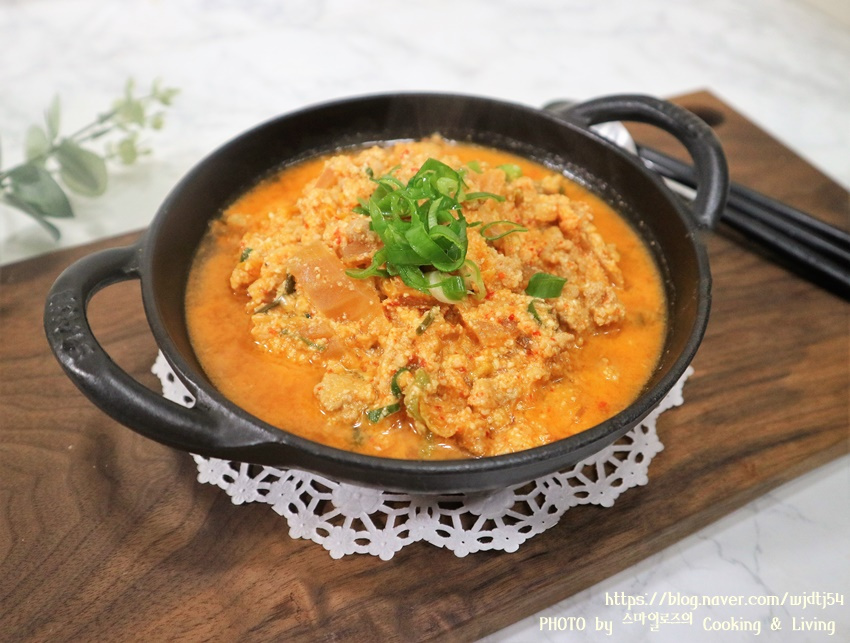Hearty and Spicy Pork Kimchi Bean Curd Stew (Kongbiji Jjigae)
How to Make Kongbiji Jjigae: A Delicious Pork and Kimchi Stew Recipe

Even though spring is here, the fluctuating temperatures can be chilly. On a day like that, I took out some aged kimchi and made a pot of this comforting stew. I prefer to grind my own beans for a fresher taste, but pre-made bean curd grounds are also readily available, which makes this recipe even easier. Let’s start making this rich, traditional, and incredibly delicious Kongbiji Jjigae together!
Stew Ingredients- Dried soybeans 1 cup (soaked for at least 5 hours or overnight)
- Ground pork 250g
- Cheongju (rice wine/cooking wine) 2 Tbsp
- 1 Korean green chili pepper, finely chopped
- 1 red chili pepper, finely chopped
- 2 Tbsp chopped green onion (white parts preferred)
- 1 Tbsp sesame oil
Seasonings and Broth- Aged kimchi 1 cup, finely chopped
- Kimchi brine 1/2 cup
- 1 Tbsp gochugaru (Korean chili flakes)
- 1 Tbsp minced garlic
- 1 Tbsp salted shrimp (or soy sauce for soup)
- 0.7 Tbsp soup soy sauce (or fish sauce)
- 2 cups anchovy-kelp broth or rice water
- Aged kimchi 1 cup, finely chopped
- Kimchi brine 1/2 cup
- 1 Tbsp gochugaru (Korean chili flakes)
- 1 Tbsp minced garlic
- 1 Tbsp salted shrimp (or soy sauce for soup)
- 0.7 Tbsp soup soy sauce (or fish sauce)
- 2 cups anchovy-kelp broth or rice water
Cooking Instructions
Step 1
First, prepare the soybeans. Soak 1 cup of dried soybeans in cold water overnight, or for at least 5 hours if you’re making it for dinner. After soaking, gently rinse the beans under running water to remove any loose skins, washing them once or twice. Drain the water. (Tip: Removing the skins will result in a smoother texture, but you can leave them on if you prefer a bit of chewiness.)

Step 2
Transfer the soaked soybeans to a blender. Since water is needed for blending, gradually add just enough water to allow the blender to work smoothly. Avoid blending it into a completely smooth paste; a slightly coarser texture with some discernible bean pieces will give the stew a more enjoyable mouthfeel. (Tip: This stew is incredibly delicious served over a bowl of hot rice!)

Step 3
Prepare the ingredients for the stew. 1 cup of dried soybeans, when soaked and blended, yields about 2 cups of bean curd grounds. Finely chop the kimchi. Use ground pork for convenience. Wash and finely chop the green onions, Korean green chili peppers, and red chili peppers.

Step 4
Heat 1 Tbsp of sesame oil in a pot over medium heat. Add 1 Tbsp of minced garlic and sauté until fragrant and lightly golden, about 30 seconds. Sautéing the garlic first will enhance its flavor.

Step 5
Add the ground pork to the pot. Break it up with a spoon to prevent clumping and cook until it’s no longer pink. Pour in 2 Tbsp of Cheongju (rice wine) to help tenderize the pork and remove any gamey odor. Stir well and continue to cook over medium heat until the pork is fully cooked.

Step 6
Once the pork is nicely browned, add the finely chopped aged kimchi to the pot. Sauté the kimchi with the pork until it softens, about 2-3 minutes. Then, add 1 Tbsp of gochugaru (chili flakes) and stir well to coat everything evenly. Cook for another minute.

Step 7
Now, add the liquid to the pot. Pour in 2 cups of anchovy-kelp broth (or rice water) and 1/2 cup of kimchi brine. These liquids will form the base of the stew’s flavor. (Tip: Using rice water can add a smoother and richer taste.)

Step 8
Season the stew for a savory depth. Add 1 Tbsp of salted shrimp and 0.7 Tbsp of soup soy sauce. If you don’t have salted shrimp, fish sauce or tuna extract can be used as a substitute. (Tip: Adjust the seasoning to your personal preference.)

Step 9
Pour the blended bean curd grounds into the pot. Stir thoroughly to ensure there are no lumps and the mixture is smooth. Cook over medium heat, stirring occasionally to prevent sticking, until the stew begins to thicken. Once it reaches your desired consistency, add the chopped green onions, Korean green chili peppers, and red chili peppers. Simmer for another minute.

Step 10
Bring the stew to a rolling boil. Your delicious and hearty Pork Kimchi Bean Curd Stew is now ready! Transferring it to a traditional Korean earthenware pot (ttukbaegi) before serving makes it even more appealing.

Step 11
Serve the hot stew directly in the pot or in individual bowls. Garnish with chopped scallions (optional) for a touch of freshness and visual appeal.

Step 12
The best way to enjoy this thick and flavorful stew is to ladle it generously over a bowl of hot rice and mix it in. It’s a truly satisfying meal, comparable to what you’d find at a specialty restaurant!

Step 13
Kongbiji Jjigae, made from soybeans, offers a unique rustic and comforting flavor profile distinct from tofu stew. I really enjoy it, and it felt wonderful to make it again after a while. Making Kongbiji Jjigae is surprisingly not difficult, is it?

Step 14
Nowadays, many convenient pre-made bean curd grounds are available, making this stew easier than ever to prepare. If you have dried soybeans, such as yellow beans, black beans, or seoritae, at home, simply soak them overnight before bed. In the morning, blend them in a mixer and cook. You can easily whip up a delicious and healthy bean curd stew.



